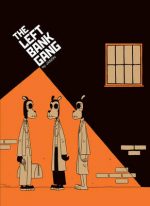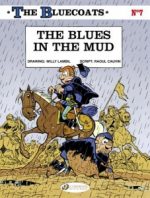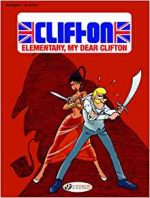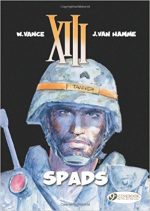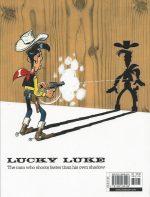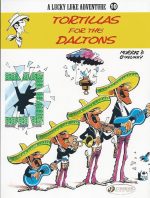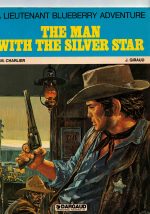
By Charlier & Giraud, translated by R. Whitener (Dargaud International)
ISBN: 2-205-06578-5
Franco-Belgian comics have enjoyed a decades-long love affair with the mythos of the American West and responded by generating some of the most beautiful and exciting graphic narratives in the history of the medium. They have, however, had less success creating characters that have gone on to be global household names.
One that did has made that jump is Michel Charlier & Jean Giraud’s immortal bad-ass Blueberry…
Sadly, although many publishers have sporadically attempted to bring him to our thrill-starved shores, there’s no readily available complete catalogue (yet) of the quintessential antihero in the English language. So here’s another ancient but superb album for you to track down. At least these gems still turn up in back-issue bins and in second-hand or charity shops…
Jean-Michel Charlier is arguably Europe’s most important writer of realistic adventure strips. He was born in Liege, Belgium in 1924 and like so many groundbreaking comics creators, began as an artist, joining the staff of Spirou in September 1944, contributing aviation illustrations and a strip about gliders co-produced with Flettner. In 1946 Charlier’s love affair with flying inspired him to co-create fighter-pilot strip Buck Danny, providing scripts for star turn artist Victor Hubinon.
Before long Рand on the advice of prestigious senior illustrator Jij̩ РCharlier was scripting full time and expanding his portfolio with many other series and serials.
In 1951 he co-created historical series Belles Histoires de l’Oncle Paul which afforded dozens of major artists their big break over the years, and supplemented the series with other strips such as Kim Devil (art Gérald Forton), Jean Valhardi and Marc Dacier (both with artist Paape) and Thierry le Chevalier (with Carlos Laffond) as well as popular scouting series La Patrouille des Castors, illustrated by MiTacq.
In conjunction with Goscinny and Uderzo, Charlier founded the business/industry oriented commercial comics agency Edifrance after which he and Goscinny edited the magazine Pistolin (1955-1958) before launching Pilote together in October 1959.
For the soon to be legendary periodical Charlier created Tanguy and Laverdure (with Uderzo and later Jijé), Barbe-Rouge (with Hubinon) and Jacques le Gall (MiTacq). After a trip to America Charlier created arguably his most significant character – and Europe’s greatest Western comic – which would eventually be known as Blueberry.
In later years, the engaging antihero would support his own equally successful spin-off La Jeunesse de Blueberry (AKA Young Blueberry, illustrated by Colin Wilson) but Charlier never rested on his laurels, concocting further grittily realistic fare: historical biographies in collaboration with Hubinon (Surcouf, Jean Mermoz, and Tarawa) and Martial Alain et Christine in Libre Junior, Rosine in Pistolin), Brice Bolt for Spirou with Aldoma Puig, Los Gringos with Victor de la Fuente and many more. He passed away in 1989.
Jean Henri Gaston Giraud was born in the suburbs of Paris on 8th May 1938. Raised by grandparents after his mother and father divorced in 1941, he began attending Institut des Arts Appliqués in 1955, becoming friends with Jean-Claude Mézières who, at 17, was already selling strips and illustrations to magazines such as Coeurs Valliants, Fripounet et Marisette and Spirou. Giraud apparently spent most of his college time drawing cowboy comics and left after a year.
In 1956 he travelled to Mexico, staying with his mother for eight months, before returning to France and a full-time career drawing comics, mostly Westerns such as Frank et Jeremie for Far West and King of the Buffalo, A Giant with the Hurons and others for Coeurs Valliants, all in a style based on French comics legend Joseph Gillain AKA “Jijéâ€.
Between 1959 and 1960 Giraud spent his National Service in Algeria, working on military service magazine 5/5 Forces Françaises before returning to civilian life as Jijé’s assistant in 1961, working on the master’s long-running (1954-1977) western epic Jerry Spring.
A year later, Giraud and Belgian writer Jean-Michel Charlier launched the serial Fort Navajo in Pilote #210. All too soon the ensemble feature threw forth a unique icon in the shabby shape of disreputable, rebellious Lieutenant Mike Blueberry who took over as the star and evolved into one of the most popular European strip characters of all time…
In 1963-1964, Giraud produced numerous strips for satire periodical Hara-Kiri and, keen to distinguish and separate the material from his serious day job, first coined his pen-name “Moebiusâ€.
He didn’t use it again until 1975 when he joined Bernard Farkas, Jean-Pierre Dionnet and Philippe Druillet – all devout science fiction fans – as founders of a revolution in narrative graphic arts created by “Les Humanoides Associesâ€.
Their ground-breaking adult fantasy magazine Métal Hurlant utterly enraptured the comics-buying public and Giraud again wanted to utilise a discreet creative persona for the lyrical, experimental, soul-searching material he was increasingly driven to produce: series such as The Airtight Garage, The Incal and the mystical, dreamy flights of sheer fantasy contained in Arzach…
To further separate his creative twins, Giraud worked his inks with a brush whilst the dedicated futurist Moebius rendered his lines with pens. After a truly stellar career which saw him become a household name, both Giraud and Moebius passed away in March 2012.
In 1977 Egmont/Methuen had published four full-colour albums which utterly failed to capture the attention of a comics-reading public besotted in equal amounts by Science Fiction in general, Star Wars in specific and new anthology 2000AD in the main…
It’s a great shame: if the translated series had launched even a year earlier, I might not be whining about lack of familiarity with a genuine classic of genre comics…
After serialisation in Pilote the Fort Navajo adventure L’Homme à l’étoile d’argent became the sixth Blueberry album and this translation was released in America and Canada in 1983.
The tale is actually a bog-standard western fable of greedy land-grabbers and a doughty town-tamer but the glimmerings of Blueberry’s unique character shine through the familiar tropes and trapping and make for a rip-raring if perhaps slightly dated read…
Two days ride from Fort Navajo, the sheriff of Silver Springs is gunned down from ambush. He’s the third in a year and the latest to tell the immensely rich and powerful Bass brothers they cannot do whatever they want.
With a cowed township and a bought-and-paid-for Judge in their pockets, the Bass boys and their pack of hired gunslingers think it’s only a matter of time before they own everything, but when pretty schoolmarm Katie Marsh swears to testify to the sheriff’s murder, nomadic old rum pot Jim MacClure convinces the honest members of the town council to send for a certain cavalryman he’s encountered in his sordid past…
After a perilous foray to the fort, the Colonel – after much effort – is convinced to despatch his troublemaking junior officer Lieutenant Mike Blueberry to investigate MacClure’s claims.
Before long the wily trouble-shooter is using all his gifts to rouse and inspire the town’s broken populace whilst whittling down the Bass brothers’ mercenary army. And when they disbelieving villains eventually try to push back, they soon realise this temporary sheriff doesn’t need the US Army to keep the peace and administer justice…
Although perhaps a tad traditional for modern tastes and nowhere near as visually or narratively sophisticated as later episodes, this sagebrush epic of the immortal Blueberry is an engaging yarn rife with gallows humour and packed with action: a stunning confirmation of the creative powers of Charlier & Giraud and potent testimony to the undying appeal and inspiration of the Western genre.
© 1969, 1983 Dargaud Editeur Paris. English language text these editions © 1983 D.I,P. All rights reserved.



